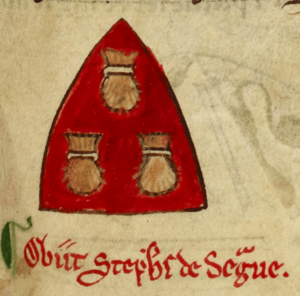Stephen de Segrave facts for kids
Quick facts for kids
Stephen de Segrave
|
|
|---|---|

Inverted shield with the arms of Stephan de Segrave
|
|
| Chief Justiciar of England | |
| In office 1232–1234 |
|
| Monarch | Henry III |
| Preceded by | Hubert de Burgh, 1st Earl of Kent |
| Succeeded by | vacant until 1258 Hugh Bigod |
| Personal details | |
| Born | c. 1171 |
| Died | 9 November 1241 |
| Spouses | Rohese le Despenser, Ida de Hastings |
| Relations | Nicholas Segrave, 1st Baron Segrave (grandson) |
| Children | Sir Gilbert de Segrave II (1202-1254) Stephen de Segrave (1204-1229) Eleonor de Segrave (1206) John de Segrave (1207-1230) |
| Parent |
|
Stephen de Segrave (born around 1171 – died November 9, 1241) was a very important person in medieval England. He served as the Chief Justiciar of England, which was like being the King's main judge and advisor.
Contents
Life of Stephen de Segrave
Stephen de Segrave was born in Leicestershire, England. His father, Gilbert de Segrave, was also an important official. He had been a High Sheriff for two counties in 1193.
Early Career and Roles
Stephen became a knight, a trained warrior who served the King. In 1220, he was made the constable of the Tower of London. This meant he was in charge of the famous Tower.
He gained a lot of land and held many different jobs under King Henry III. These jobs included being a High Sheriff in several counties:
- From 1221 to 1223, he was Sheriff of Hertfordshire and Essex.
- From 1222 to 1224, he was Sheriff of Lincolnshire.
- From 1228 to 1234, he was Sheriff of Bedfordshire and Buckinghamshire.
- From 1229 to 1234, he was Sheriff of Warwickshire, Leicestershire, and Northamptonshire.
In 1236, Stephen became the castellan (or commander) of Beeston Castle and Chester Castle. He shared this role with two other important people.
Important Land Holdings
Stephen was given the land where Caludon Castle was later built. This was near Coventry and was given to him by a powerful nobleman, Ranulph de Blondeville, 4th Earl of Chester, around 1232. Ranulph also gave him land in Bretby in 1209.
Chief Justiciar of England
In 1232, Stephen de Segrave took over as the Chief Justiciar of England. This was a very powerful position. He replaced Hubert de Burgh, 1st Earl of Kent.
Stephen was involved in a major trial of Hubert de Burgh in November 1232. Stephen was a close advisor to the King. In 1234, he lost his job as Chief Justiciar. However, he soon returned to an important role at King Henry's court and stayed influential until he died.
Later, Stephen became a canon (a type of priest) at Leicester Abbey. He died there on November 9, 1241, and was buried at the abbey.
Family Life
Stephen de Segrave was married twice. His first wife was Rohese le Despencer. They had three sons and one daughter together. His second wife was Ida de Hastings.
Children of Stephen de Segrave
Here are the children he had with Rohese le Despencer:
- Sir Gilbert de Segrave II (born 1202 - died 1254): He married Amabilia de Chaucombe. They had children named Alice de Segrave, Margaret de Vere, and Nicholas de Segrave, 1st Baron Segrave.
- Stephen de Segrave (born 1204 - died 1229)
- Eleonor de Segrave (born 1206): She married Robert Hovell.
- John de Segrave (born 1207 - died 1230): He married Emma de Cauz.
Stephen's grandson, Nicholas, became the first Baron Segrave. This title is now connected with the title of Baron Mowbray.

